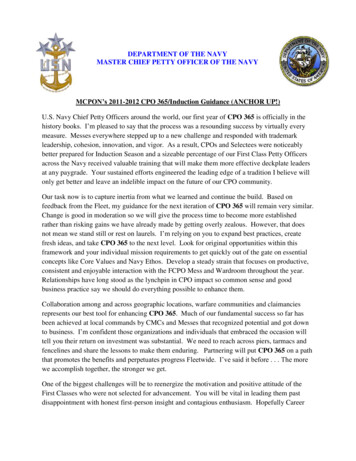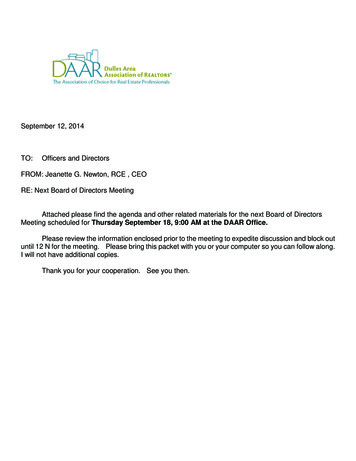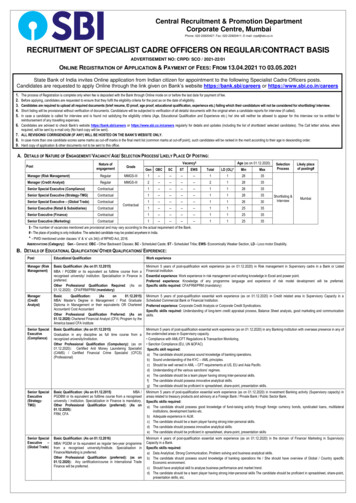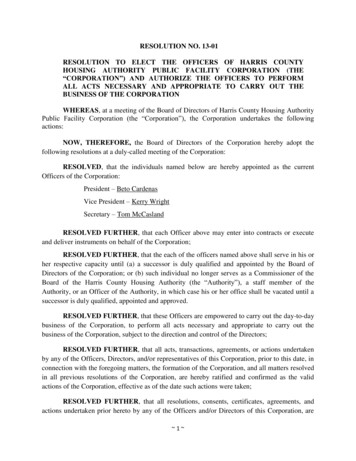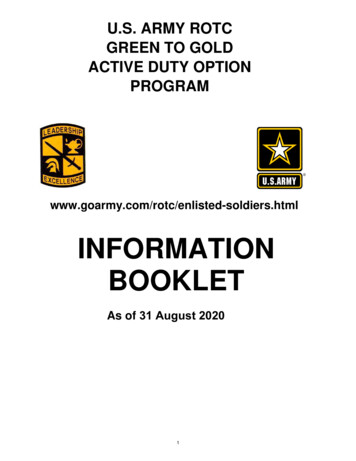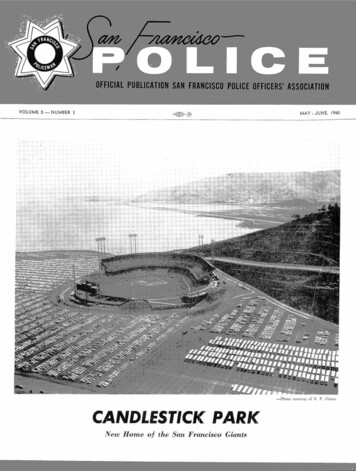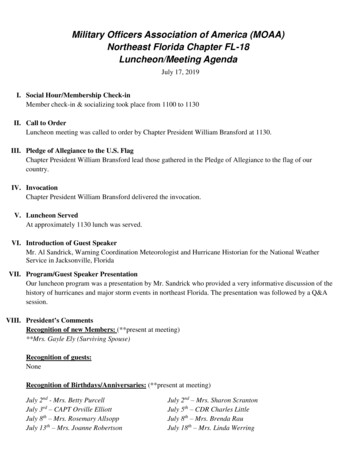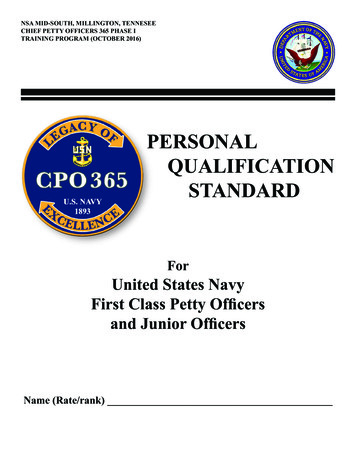
Transcription
NSA MID-SOUTH, MILLINGTON, TENNESEECHIEF PETTY OFFICERS 365 PHASE ITRAINING PROGRAM (OCTOBER 2016)PERSONALQUALIFICATIONSTANDARDForUnited States NavyFirst Class Petty Officersand Junior OfficersName (Rate/rank)
DISTRUBUTION NOTICE: Intended for any E6 and below, E7 or Junior Officer that is interested in their developmentas a forward-leaning Deckplate Leader.PREFACEChief Petty Officers are an essential element of our Navy’s Operational Primacy. The objective of the CPO 365 PhaseI Program is to provide the First Class Petty Officer or Junior Officer an introduction into the processes and topicsnecessary to support the junior Sailor, the Chief’s Mess and the wide scope of mission requirements our Navy faces today.This personnel qualification standard will focus on mission effectiveness, combat readiness, individual readiness and anoverall understanding of how the unit mission fits into and supports Navy Doctrine. Experience shows it is essential thatevery Chief Petty Officer in our Navy be totally familiar with the mission of their command and be able to apply thisknowledge to support the successful execution of the command’s current and future obligations.2
Table Of ContentsAcknowledgements5Introduction 6Acronyms 7100Introduction to Fundamentals 8101Unit Level AdministrationBrilliant on the Basics27Evaluations and Fitness Reports28Medical and Dental Readiness29Defense Travel System/GTCC30Mobilization Readiness31Family Readiness/Ombudsman Program32Recognition and Awards34Physical Readiness35Performance Counseling35Transaction Online Processing System36Navy Reserve Readiness Module37102Professional DevelopmentOnline Electronic Service Records, ESR/PSR38Web-Enabled Record ReviewEvaluation ContinuitySmartCareer Development BoardsCareer Management System103Navy Customs, Traditions And HistoryColors39Military Courtesies40Navy History40Social Usage and Protocol42104Military Forces FundamentalsNational Strategy and Maritime Policy43Authority and Chain Of CommandCombatant CommandersFunctional Component CommandersMaritime Pre-Postioning ForceMission Platform Diversity3
Table Of Contents(continued)105Drills And CeremoniesGeneral Rules of DrillSquad DrillGuidon RulesInspectionsAwards Presentations106Military ProgramsExceptional Family MemberNavy and Marine Corps Relief SocietyFleet and Family Service CenterDiversityNavy One-SourceNavy CollegeCasualty Assistance Call OfficerCommand Managed Equal OpportunityGI Bill107Navy RegulationsStandard Organization and Regulations Manual108Navy UniformsUniforms and Grooming Standards109Navy Core ValuesMCPON’s Mission, Vision and Guiding Principles110LegalReport ChitsExtra Military InstructionDisciplinary Review BoardUniform Code of Military JusticeJudge Advocate General Manual200Introduction to Watchstations201Watch Stations300First Class Petty Officer Tasking4444649495152545556
AcknowledgementsThe developers of the PQS gratefully acknowledge the assistance, dedication andprofessionalism of the following Chief Petty Officers while writing this PQS.CMDCM Marilyn KennardMACM Pat KillingerMMCM Bill GeorgeNCCS Angela KeenMCCS David CrawfordHMCS Cory AnglinPSCS Jeruel SimsuangoAECS Mary ChesnuttHMCS Jim CarboneYNCS Linda WilliamsLSCS Justin ButlerCTICS Micah EpleyYNCS Mike CampbellAOCS Missy HackneyNCC Tara VallsAZC Anishia WhitelyATC Tom SellersNCC Robert RiveraACC Stephen HowardOSC Travone SteeleNCC Homer RealubitHMC Roger BarnettAZC Eric LloydNCC Gary WilliamsCTTC Dave GarrisonAZC Terri LeeAWSC Curtis ClontzHTC Lucas PawlowskiEOC Lee WoodATC Ronnie LeathersHMC Meredith JohnsonAWVC Tara BlairMCC Isaiah SellersCTMC John HibbertsCEC Nate StewartEOC Jason CummingsAEC Ian MacGregorYNC Felipe GarciaPSC Matt NelsonPSC Sonny DeleonITC Rob StalcupNSA MID SOUTHNPC, PERS-405NAVMACCNRC MILLINGTON, TNNPC, PERS-405NAVMACNPC, PERS-405NAVMACBUPERS 32NAVMACNPC, PERS-4012NPC, PERS-408NPC, PERS-409NPC, PERS-404NRC MILLINGTON, TNNPC, PERS-404NAVMACNRC MILLINGTON, TNNPC, PERS-404NAVMACNRC MILLINGTON, TNNPC, PERS-4015NAVMACNRC MILLINGTON, TNNPC, PERS-408NAVMACNPC, PERS-4013NPC, PERS-402NPC, PERS-4013NPC, PERS-4013NPC, PERS-407NPC, PERS-404CHINFO, NAVCONPC, PERS-408NPC, PERS-401NPC, PERS-401NPC, PERS-4013NPC, PERS-4012NPC, PERS-40NPC, PERS4010NPC, PERS-4013Changes, updates or questions can be forwarded to the PQS Coordinator at:cpo365trainingcommittee@gmail.comAn answer key is also available to any Chief upon request.5
IntroductionPQS PROGRAMThis PQS program is a qualification system for First Class Petty Officers where certification at a minimum level ofcompetency is required prior to “CPO 365 Phase II” or “Chief Petty Officer.” The PQS is a compilation of the minimumknowledge and tasks that an individual must demonstrate in order to earn and wear the uniform of a Chief Petty Officer.The objectives of this PQS are to standardize and provide a solid base of experience by completing this qualification.CANCELLATIONThis standard cancels and supersedes any CPO 365 manual prior to 16 September 2016.APPLICABILITYThis PQS is applicable to all First Class Petty Officers assigned to NSA Mid-South Millington, Tenn., region. First ClassPetty Officers assigned to tenant commands are also subject to this requirement.TAILORINGTo command-tailor this package, first have it reviewed by one or more of your most qualified Master Chiefs. Next,additions to this PQS to fulfill local training requirements will be submitted to and approved by the Senior Enlisted Leaderand or Command Master Chief of NSA Mid-South Millington, Tenn.QUALIFIERQualifiers are Chief Petty Officers only! For more information on the duties and responsibilities of PQS Qualifiers,respectfully process your queries via your leading Chief Petty Officers and/or Command Master Chief.CONTENTSThis PQS contains knowledge items, watch-station requirements and tasking necessary for satisfactory understanding ofthe roles and minimum responsibilities required of a Chief Petty Officer.REFERENCESThe references used to create this PQS package were the latest available. However, the most current references availableshould be used when qualifying with this Standard. This is not a valid excuse for not obtaining a signature.FIRST CLASS PETTY OFFICERYour leading Chief Petty Officer will guide you in the order of precedence for PQS completion. You must complete allfundamentals, pre-requisites and tasking prior to the qualification of any watch stations. If you have any questions or areunable to locate references, contact your Division LCPO, Departmental LCPO, Boat Team Leading Chief Petty Officer, orTraining Committee Chairperson.PQS FEEDBACK REPORTSFirst Class Petty Officers, your feedback is welcomed and required. Refrain from simply complaining about what you didnot like. Present your area of concern and your solution to correct the concern.6
Acronyms Used in this PQSNot all acronyms or abbreviations used in this PQS are defined here. The Subject Matter Experts from the Chiefs whowrote this standard determined the following acronyms and abbreviations may not be commonly known throughout thecommunity and should be defined to avoid confusion. If there is a question concerning an acronym or abbreviation notidentified on this page or anywhere else within the standard, use the references listed on the line to locate the SQRUADSGLISOPASORMUAUCMJUSERRAUSFFCAdministrative SeparationBody Composition AssessmentDisciplinary Review BoardCasualty Assistance Calls OfficerCareer Development BoardCommand Managed Equal OpportunityDelay, Deferment, ExemptionDefense Enrollment Eligibility Reporting SystemExceptional Family MemberExtra Military InstructionEmployer Support of the Guard and ReserveElectronic Service RecordFleet Family Service CenterFragmentation OrderIn Assignment ProcessingIn Accordance WithInactive Duty Training TravelInactive Ready ReserveImmediate Superior In CommandJudge Advocate General ManualMaritime Civil AffairsMoral Welfare RecreationMaster Chief Petty Officer of the NavyNaval Construction ForceNavy Expeditionary Combat CommandNavy and Marine Corps Relief SocietyNavy Standard Integrated Personnel SystemNavy Service UniformNavy Working UniformOperations OrderPhysical Fitness AssessmentPerform To ServePerformance Mark AveragePerformance Summary RecordReserve Component CommandReady Reserve Screening QuestionnaireReserve Unit Assignment DocumentService Member’s Group Life InsuranceSenior Officer Present AfloatStandard Organization and Regulations ManualUnauthorized AbsenceUniform Code of Military JusticeUniform Services Employment and Reemployment ActUnited States Fleet Forces Command7
100 - Introduction To Fundamentals100.1 INTRODUCTIONThis PQS begins with a fundamentals section covering the basic knowledge and principles. If you need a refresher or areunfamiliar with this material, the references listed will aid you in completing this PQS. All references cited for study areselected according to their credibility and availability.100.2 HOW TO COMPLETEYou should complete all required fundamentals before starting the watch station portions of this PQS since knowledgegained from fundamentals will aid you in understanding the mission areas and your watch station tasking. When you feelyou have a complete understanding of one fundamental or more, contact your Chief Petty Officer. If attempting initialqualification, the Chief Petty Officers will expect you to satisfactorily answer each line item listed in the fundamentalsprior to signing the fundamental. If you are one of the four lucky Sailors of the Quarter (SOQ), your Sponsor may requireyou to answer representative line items to determine if you have retained the necessary knowledge for your watch station.If your command requires an oral board or written examination for final qualification, you may be asked any questionsfrom the fundamentals required for your watch station.8
FUNDAMENTALSUnderstanding Deckplate LeadershipDeckplate Leadership: Chiefs are visible leaders who set the tone. We will know the mission, know our Sailors, anddevelop them beyond their expectations as a team and as individuals.1. In your own words define, “Deckplate Leadership.”2. Outline how you apply your leadership style to the Navy’s Brilliant on the Basics programs.3. With regards to leadership, what is the most effective way of being visible and setting the tone within your work center,division, and command?4. What is the mission of your command and the United States Navy?5. List three ways you develop your Sailors beyond their expectations as a team.6. List three ways you develop your Sailors beyond their expectations as individuals.7. What are the benefits of being a proactive leader engaged on the deckplates?8. How do you train junior Sailors, officers and enlisted, to be better leaders?9. Outline three best practices you have seen at past commands that worked well with regards to leadership and beingvisible at the deckplate level.10. What are the effects or impact to a command where FCPOs and CPO Mess are not leading on the deckplates?Answers:9
10
Guidance: SELs and LCPOs should ensure FCPOs under their charge are provided guidance with regards to DeckplateLeadership and the CPO MVGPs. Once the task is complete, sit down with the FCPO and discuss their answers. Welcometheir thoughts and comments and provide solid advice based on your experiences. If warranted, add any additionalquestions to bring clarity. If there are any items that are unclear, it is recommended that you provide the guidancenecessary for the Sailor to complete the section.(SEL/LCPO Signature and date)11
FUNDAMENTALSUnderstanding Institutional and Technical ExpertiseInstitutional and Technical Expertise: Chiefs are experts in their field. We will use experience and technical knowledgeto produce a well-trained enlisted and officer team.1. Define the term, “Institutional expertise.”.2. Define the term, “Technical expertise.”3. Describe how you, as a FCPO and future Chief, use your experience to train officers and enlisted.4. Describe the importance of maintaining your technical expertise.5. List three ways you apply your technical expertise and knowledge to produce a well-trained enlisted and officer team.6. As an expert many will come to you seeking solutions. Occasionally, you will be faced with an issue to which you donot have the answer. As a FCPO, what do you do when placed in this situation?7. Other than your rating, outline other areas in which a FCPO and Chief are considered technical experts. Include allNavy programs, command duties and responsibilities, and warfare community specifics.8. Finish the following sentence: “As a future Chief it is important that I maintain my technical expertise because ”9. What is the difference between being a leader and being a technical and institutional expert? Is there a difference, inyour opinion, and if so what is your reasoning?10. Often, as leaders, we are placed in positions of authority that are out of our rating. A few examples of this areCommand DAPAs, Command Fitness Leaders, and 3M Coordinators. If placed in this type of position, what course ofaction would you take to become the technical and institutional leader in your new leadership role?Answers:12
13
Guidance: SELs and LCPOs should ensure FCPOs under their charge are provided guidance with regards to DeckplateLeadership and the CPO MVGPs. Once the task is complete, sit down with the FCPO and discuss their answers. Welcometheir thoughts and comments and provide solid advice based on your experiences. If warranted, add any additionalquestions to bring clarity. If there are any items that are unclear, it is recommended that you provide the guidancenecessary for the Sailor to complete the section.(SEL/LCPO Signature and date)14
FUNDAMENTALSUnderstanding ProfessionalismProfessionalism: Chiefs will actively teach, uphold, and enforce standards. We will measure ourselves by the success ofour Sailors. We will remain invested in the Navy through self-motivated military and academic education and training andwill provide proactive solutions that are well-founded, thoroughly considered, and linked to mission accomplishment.1. In your own words, define Professionalism.2. How do you, as a FCPO and future Chief, actively teach, uphold, and enforce Navy and command standards?3. As a leader we measure ourselves by the success of our Sailors. Describe the different metrics available we can use tomeasure Sailor success. Example: Command Climate Survey.4. Why is maintaining academic education and training important?5. What is the difference between a reactionary solution and a proactive solution? What are the benefits of being aproactive leader? Is being a reactive leader necessary at times? Explain.6. How is professionalism linked to mission readiness?7. Define what a well-founded solution means to you.8. Enforcing standards is very important. As leaders, we set the example at all times. What actions would you take ifleaders within your organization are not adhering to standards?9. List those areas that you feel truly are a measurement of the command climate. As a professional what do you do toimprove these areas? Example: High Attrition.10. Finish this sentence: “A leader who is unprofessional and does not enforce standards ”Answers:15
16
Guidance: SELs and LCPOs should ensure FCPOs under their charge are provided guidance with regards to DeckplateLeadership and the CPO MVGPs. Once the task is complete, sit down with the FCPO and discuss their answers. Welcometheir thoughts and comments and provide solid advice based on your experiences. If warranted, add any additionalquestions to bring clarity. If there are any items that are unclear, it is recommended that you provide the guidancenecessary for the Sailor to complete the section.(SEL/LCPO Signature and date)17
FUNDAMENTALSUnderstanding Character and LoyaltyCharacter: Chiefs abide by an uncompromising code of integrity, take full responsibility for their actions and keep theirword. This will set a positive tone for the command, unify the Mess, and create esprit de corps.Loyalty: Chiefs remember that loyalty must be demonstrated to seniors, peers and subordinates alike, and that it mustnever be blind. Few things are more important than people who have the moral courage to question the appropriatedirection in which an organization is headed and then the strength to support whatever final decisions are made.1. In your own words, define Character.2. In your own words, define Loyalty.3. What does abiding by an uncompromising code of integrity mean to you?4. What are some of the attributes that define true character?5. How does abiding by an uncompromising code of integrity unify FCPOs and the CPO Mess and create esprit de corps?6. What is meant by, “What is said in the Mess, seen in the Mess and heard in the Mess . . . stays in the Mess?” How doesloyalty factor into this saying?7. What is meant by: “Acceptance is not agreement?” How does this apply to the previous line item?8. List some of the basic characteristics of a loyal Sailor.9. Finish this sentence: “A Chief with uncompromising character and true loyalty is ”10. What is meant by “loyalty never being blind?”Answers:18
19
Guidance: SELs and LCPOs should ensure FCPOs under their charge are provided guidance with regards to DeckplateLeadership and the CPO MVGPs. Once the task is complete, sit down with the FCPO and discuss their answers. Welcometheir thoughts and comments and provide solid advice based on your experiences. If warranted, add any additionalquestions to bring clarity. If there are any items that are unclear, it is recommended that you provide the guidancenecessary for the Sailor to complete the section.(SEL/LCPO Signature and date)20
FUNDAMENTALSUnderstanding Active CommunicationActive Communication: Chiefs encourage open and frank dialog, listen to Sailors and energize the communication flowup and down the chain of command. This will increase unit efficiency, mission readiness, and mutual respect.1. In your own words define “Active Communication.”2. As a FCPO and future Chief, how do you encourage open and frank dialog within your division?3. Give examples of ways to energize communication flow.4. In the MVGPs it states that, active communication will increase unit efficiency, mission readiness, and mutual respect.How and why is this?5. What are some best practices that you have seen that enhanced the flow of communication up and down the chain ofcommand?6. With regards to communication, why is a difference of opinion, in some cases, a good thing?7. When addressing Sailors in large group forums what are some do’s and don’t’s with regards to communication?8. What do you think is meant by the saying, “Silence is Golden?” How can not saying anything be beneficial?9. When conducting one-on-one counseling, outline different methods you can apply to enhance the communication flow.10. In the following situations how do you communicate your opinion if it differs from what is being discussed:a. All-hands callb. FCPO Mess meetingc. Division Quartersd. One-on-one counseling11. In the following situations how do you communicate your opinion if it differs from what is being discussed:a. CPO Mess/ FCPOA meetingb. Chiefs and/or Officers callAnswers:21
22
Guidance: SELs and LCPOs should ensure FCPOs under their charge are provided guidance with regards to DeckplateLeadership and the CPO MVGPs. Once the task is complete, sit down with the FCPO and discuss their answers. Welcometheir thoughts and comments and provide solid advice based on your experiences. If warranted, add any additionalquestions to bring clarity. If there are any items that are unclear, it is recommended that you provide the guidancenecessary for the Sailor to comp
The objective of the CPO 365 Phase I Program is to provide the First Class Petty Officer or Junior Officer an introduction into the processes and topics necessary to support the junior Sailor, the Chief’s Mess and the
